有关翻译的论文选题范文
- 格式:doc
- 大小:131.50 KB
- 文档页数:10
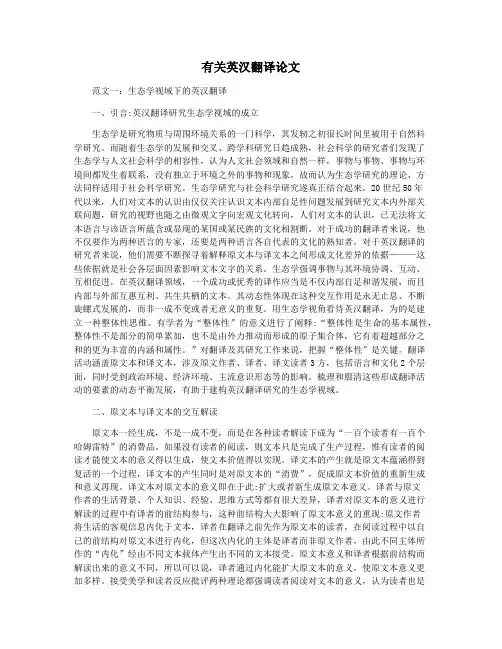
有关英汉翻译论文范文一:生态学视域下的英汉翻译一、引言:英汉翻译研究生态学视域的成立生态学是研究物质与周围环境关系的一门科学,其发轫之初很长时间里被用于自然科学研究。
而随着生态学的发展和交叉、跨学科研究日趋成熟,社会科学的研究者们发现了生态学与人文社会科学的相容性,认为人文社会领域和自然一样,事物与事物、事物与环境间都发生着联系,没有独立于环境之外的事物和现象,故而认为生态学研究的理论、方法同样适用于社会科学研究。
生态学研究与社会科学研究遂真正结合起来。
20世纪50年代以来,人们对文本的认识由仅仅关注认识文本内部自足性问题发展到研究文本内外部关联问题,研究的视野也随之由微观文字向宏观文化转向,人们对文本的认识,已无法将文本语言与该语言所蕴含或显现的某国或某民族的文化相割断。
对于成功的翻译者来说,他不仅要作为两种语言的专家,还要是两种语言各自代表的文化的熟知者。
对于英汉翻译的研究者来说,他们需要不断探寻着解释原文本与译文本之间形成文化差异的依据———这些依据就是社会各层面因素影响文本文字的关系。
生态学强调事物与其环境协调、互动、互相促进。
在英汉翻译领域,一个成功或优秀的译作应当是不仅内部自足和谐发展,而且内部与外部互惠互利、共生共栖的文本。
其动态性体现在这种交互作用是永无止息、不断旋螺式发展的,而非一成不变或者无意义的重复。
用生态学视角看待英汉翻译,为的是建立一种整体性思维。
有学者为“整体性”的意义进行了阐释:“整体性是生命的基本属性,整体性不是部分的简单累加,也不是由外力推动而形成的原子集合体,它有着超越部分之和的更为丰富的内涵和属性。
”对翻译及其研究工作来说,把握“整体性”是关键。
翻译活动涵盖原文本和译文本,涉及原文作者、译者、译文读者3方,包括语言和文化2个层面,同时受到政治环境、经济环境、主流意识形态等的影响。
梳理和廓清这些形成翻译活动的要素的动态平衡发展,有助于建构英汉翻译研究的生态学视域。
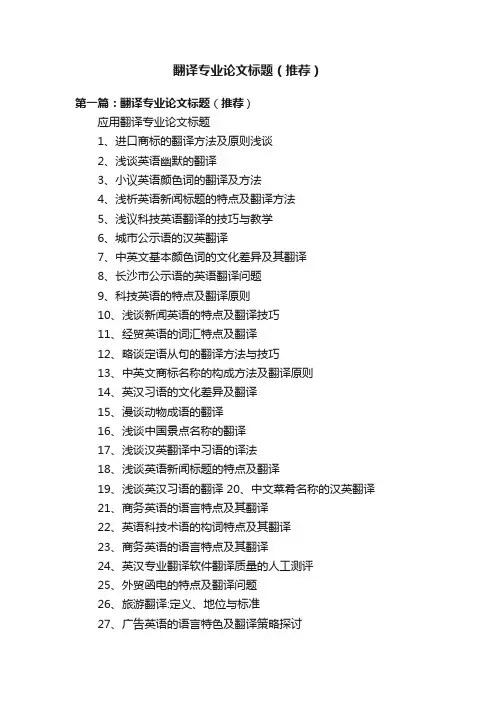
翻译专业论文标题(推荐)第一篇:翻译专业论文标题(推荐)应用翻译专业论文标题1、进口商标的翻译方法及原则浅谈2、浅谈英语幽默的翻译3、小议英语颜色词的翻译及方法4、浅析英语新闻标题的特点及翻译方法5、浅议科技英语翻译的技巧与教学6、城市公示语的汉英翻译7、中英文基本颜色词的文化差异及其翻译8、长沙市公示语的英语翻译问题9、科技英语的特点及翻译原则10、浅谈新闻英语的特点及翻译技巧11、经贸英语的词汇特点及翻译12、略谈定语从句的翻译方法与技巧13、中英文商标名称的构成方法及翻译原则14、英汉习语的文化差异及翻译15、漫谈动物成语的翻译16、浅谈中国景点名称的翻译17、浅谈汉英翻译中习语的译法18、浅谈英语新闻标题的特点及翻译19、浅谈英汉习语的翻译 20、中文菜肴名称的汉英翻译21、商务英语的语言特点及其翻译22、英语科技术语的构词特点及其翻译23、商务英语的语言特点及其翻译24、英汉专业翻译软件翻译质量的人工测评25、外贸函电的特点及翻译问题26、旅游翻译:定义、地位与标准27、广告英语的语言特色及翻译策略探讨28、科技英语中被动语态的特点及翻译方法29、浅析英语广告的修辞特点及翻译 30、长沙市旅游公示语翻译现状及对策31、商标及广告词的翻译原则与策略32、广告英语的语言特色、翻译标准及策略33、浅谈因特网辅助翻译的若干方法和技巧34、如何看待翻译中否定句式及其汉译问题35、英语长难句的翻译36、简议科技英语翻译长句的处理37、浅谈英汉成语及俗语翻译38、英语被动语态的翻译研究39、浅析英语谚语的特点及翻译技巧 40、浅议英语新闻标题的特点和翻译技巧41、英语定冠词的用法与翻译42、口译中数字的翻译43、试论英语口译中数字的译法44、漫谈英语否定之翻译45、中英文电影名翻译及其比较46、浅谈英语习语的翻译47、浅谈法律英语的特点及翻译48、浅析英语专有名词的翻译49、浅谈英语否定句型及其翻译 50、英语被动语态的翻译技巧51、英语否定结构的特点及翻译52、论英汉典故的翻译53、大学英语翻译教学的现状及改进方法54、信息社会对翻译教学的影响55、国内翻译软件的现状和发展方向56、浅议中外典故习语的翻译57、涉外经济合同的特点和翻译58、论即席翻译过程中的口译记录59、英语倍数的句型及翻译60、科技英语词汇的特点、构成及其翻译 61、谈商务英语的特点和翻译 62、浅析中式菜谱的文化和翻译 63、汉英公示语的翻译 64、英语商品名称的翻译65、商务广告英语的特点及其翻译技巧66、委婉语的翻译67、英汉翻译中隐喻的处理68、英汉翻译中的直译与意译69、英汉谚语的特色与翻译70、浅析直译与意译在英语广告汉译中的运用 71、合同的语篇特点及翻译 72、颜色词的翻译第二篇:如何翻译论文标题、摘要如何翻译论文标题、摘要题名的结构。
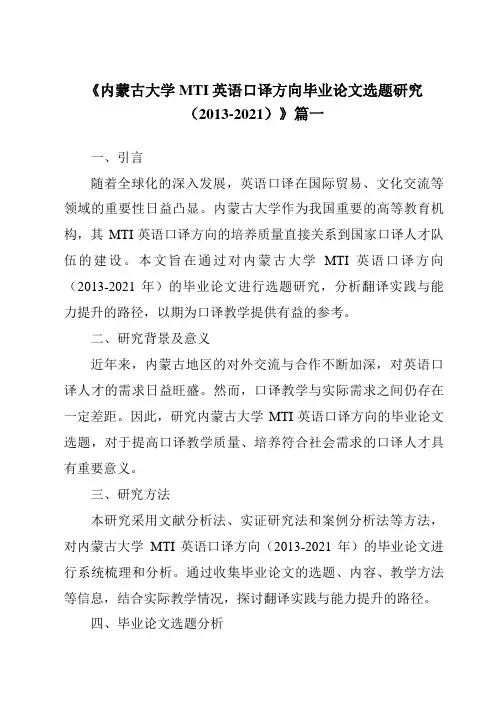
《内蒙古大学MTI英语口译方向毕业论文选题研究(2013-2021)》篇一一、引言随着全球化的深入发展,英语口译在国际贸易、文化交流等领域的重要性日益凸显。
内蒙古大学作为我国重要的高等教育机构,其MTI英语口译方向的培养质量直接关系到国家口译人才队伍的建设。
本文旨在通过对内蒙古大学MTI英语口译方向(2013-2021年)的毕业论文进行选题研究,分析翻译实践与能力提升的路径,以期为口译教学提供有益的参考。
二、研究背景及意义近年来,内蒙古地区的对外交流与合作不断加深,对英语口译人才的需求日益旺盛。
然而,口译教学与实际需求之间仍存在一定差距。
因此,研究内蒙古大学MTI英语口译方向的毕业论文选题,对于提高口译教学质量、培养符合社会需求的口译人才具有重要意义。
三、研究方法本研究采用文献分析法、实证研究法和案例分析法等方法,对内蒙古大学MTI英语口译方向(2013-2021年)的毕业论文进行系统梳理和分析。
通过收集毕业论文的选题、内容、教学方法等信息,结合实际教学情况,探讨翻译实践与能力提升的路径。
四、毕业论文选题分析(一)选题类型通过对内蒙古大学MTI英语口译方向毕业论文的梳理,发现选题类型主要包括:会议口译、商务口译、文化交流口译、旅游口译等。
这些选题紧密结合社会实际需求,体现了学校对口译教学的重视。
(二)选题特点1. 实践性:毕业论文多以实际翻译项目为基础,注重实践操作和案例分析。
2. 创新性:选题涉及领域广泛,涵盖了口译教学的多个方面,具有较高的创新性。
3. 针对性:选题紧密结合社会需求和行业发展趋势,具有较强的针对性。
(三)翻译实践与能力提升的路径1. 理论与实践相结合:通过实际翻译项目,将理论知识与实践相结合,提高学生的口译技能和应变能力。
2. 多元化教学:采用多种教学方法和手段,如模拟口译、实地口译等,丰富教学内容和形式。
3. 跨文化交际能力培养:加强对学生跨文化交际能力的培养,提高其在不同文化背景下的口译能力。
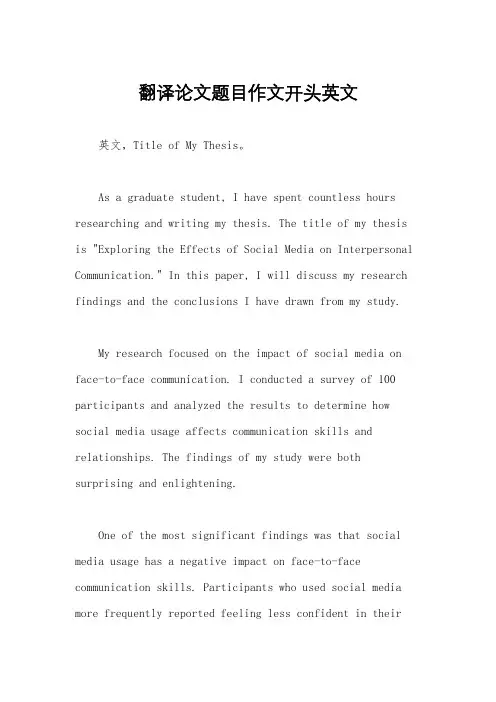
翻译论文题目作文开头英文英文,Title of My Thesis。
As a graduate student, I have spent countless hours researching and writing my thesis. The title of my thesis is "Exploring the Effects of Social Media on Interpersonal Communication." In this paper, I will discuss my research findings and the conclusions I have drawn from my study.My research focused on the impact of social media on face-to-face communication. I conducted a survey of 100 participants and analyzed the results to determine how social media usage affects communication skills and relationships. The findings of my study were both surprising and enlightening.One of the most significant findings was that social media usage has a negative impact on face-to-face communication skills. Participants who used social media more frequently reported feeling less confident in theirability to communicate effectively in person. Additionally, those who spent more time on social media reported feeling more isolated and less connected to their peers.中文,我的论文题目。
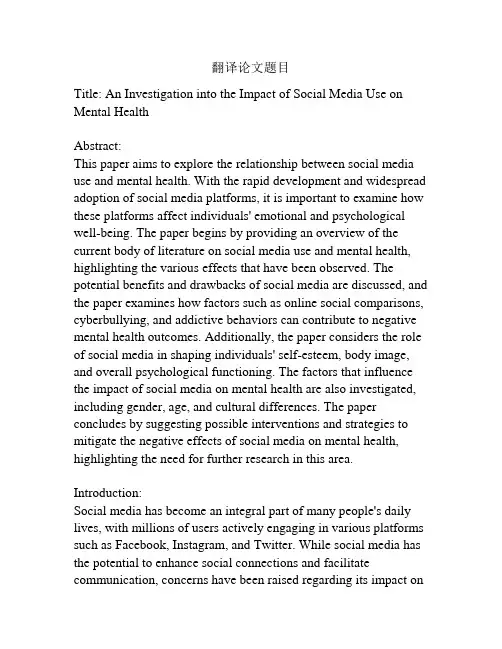
翻译论文题目Title: An Investigation into the Impact of Social Media Use on Mental HealthAbstract:This paper aims to explore the relationship between social media use and mental health. With the rapid development and widespread adoption of social media platforms, it is important to examine how these platforms affect individuals' emotional and psychological well-being. The paper begins by providing an overview of the current body of literature on social media use and mental health, highlighting the various effects that have been observed. The potential benefits and drawbacks of social media are discussed, and the paper examines how factors such as online social comparisons, cyberbullying, and addictive behaviors can contribute to negative mental health outcomes. Additionally, the paper considers the role of social media in shaping individuals' self-esteem, body image, and overall psychological functioning. The factors that influence the impact of social media on mental health are also investigated, including gender, age, and cultural differences. The paper concludes by suggesting possible interventions and strategies to mitigate the negative effects of social media on mental health, highlighting the need for further research in this area. Introduction:Social media has become an integral part of many people's daily lives, with millions of users actively engaging in various platforms such as Facebook, Instagram, and Twitter. While social media has the potential to enhance social connections and facilitate communication, concerns have been raised regarding its impact onmental health. This paper seeks to investigate the relationship between social media use and mental health, examining the various factors that contribute to positive or negative outcomes. Literature Review:Numerous studies have explored the effects of social media use on mental health. Some research suggests that excessive social media use can lead to negative mental health outcomes, such as increased anxiety, depression, and loneliness. Online social comparisons have been identified as a significant factor, with individuals often comparing themselves unfavorably to others on social media platforms. Cyberbullying is another issue of concern, as it can have detrimental effects on victims' mental well-being. Moreover, addictive behaviors related to social media use, such as excessive scrolling and constant checking of notifications, can contribute to negative mental health outcomes.Impact on Self-esteem and Body Image:The paper also investigates the impact of social media on individuals' self-esteem and body image. Research suggests that exposure to highly curated and idealized images on social media can lead to feelings of inadequacy and dissatisfaction with one's own appearance. The constant pressure to meet unrealistic beauty standards portrayed on these platforms can significantly impact individuals' self-esteem and body image.Factors Influencing the Impact:Several factors can influence the impact of social media on mental health. Gender differences have been observed, with females generally reporting more negative effects on mental health thanmales. Age is another significant factor, with adolescents and young adults being particularly vulnerable to the negative effects of social media use. Cultural differences also play a role, with studies highlighting varying perceptions and responses to social media across different cultural contexts.Conclusion:Given the widespread usage of social media and its potential impact on mental health, it is crucial to further investigate this relationship. Efforts should be made to raise awareness about the potential risks associated with excessive social media use and develop interventions to mitigate these negative effects. Strategies such as promoting digital literacy, fostering healthy online behaviors, and encouraging offline social connections can help individuals maintain positive mental well-being in the digital age. Further research is needed to deepen our understanding of the complexities surrounding social media use and mental health, and to develop evidence-based interventions to promote psychological well-being in the digital era.。
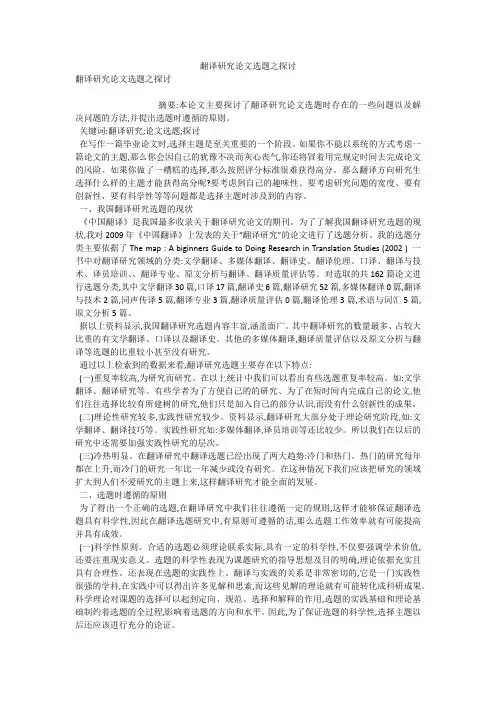
翻译研究论文选题之探讨翻译研究论文选题之探讨摘要:本论文主要探讨了翻译研究论文选题时存在的一些问题以及解决问题的方法,并提出选题时遵循的原则。
关键词:翻译研究;论文选题;探讨在写作一篇毕业论文时,选择主题是至关重要的一个阶段。
如果你不能以系统的方式考虑一篇论文的主题,那么你会因自己的犹豫不决而灰心丧气,你还将冒着用完规定时间去完成论文的风险。
如果你做了一糟糕的选择,那么按照评分标准很难获得高分。
那么翻译方向研究生选择什么样的主题才能获得高分呢?要考虑到自己的趣味性、要考虑研究问题的宽度、要有创新性、要有科学性等等问题都是选择主题时涉及到的内容。
一、我国翻译研究选题的现状《中国翻译》是我国最多收录关于翻译研究论文的期刊。
为了了解我国翻译研究选题的现状,我对2009年《中国翻译》上发表的关于“翻译研究”的论文进行了选题分析。
我的选题分类主要依据了The map : A biginners Guide to Doing Research in Translation Studies (2002 ) 一书中对翻译研究领域的分类:文学翻译、多媒体翻译、翻译史、翻译伦理、口译、翻译与技术、译员培训、、翻译专业、原文分析与翻译、翻译质量评估等。
对选取的共162篇论文进行选题分类,其中文学翻译30篇,口译17篇,翻译史6篇,翻译研究52篇,多媒体翻译0篇,翻译与技术2篇,同声传译5篇,翻译专业3篇,翻译质量评估0篇,翻译伦理3篇,术语与词汇5篇,原文分析5篇。
据以上资料显示,我国翻译研究选题内容丰富,涵盖面广。
其中翻译研究的数量最多、占较大比重的有文学翻译、口译以及翻译史。
其他的多媒体翻译,翻译质量评估以及原文分析与翻译等选题的比重较小甚至没有研究。
通过以上检索到的数据来看,翻译研究选题主要存在以下特点:(一)重复率较高,为研究而研究。
在以上统计中我们可以看出有些选题重复率较高。
如:文学翻译、翻译研究等。
有些学者为了方便自己的的研究、为了在短时间内完成自己的论文,他们往往选择比较有所建树的研究,他们只是加入自己的部分认识,而没有什么创新性的成果。
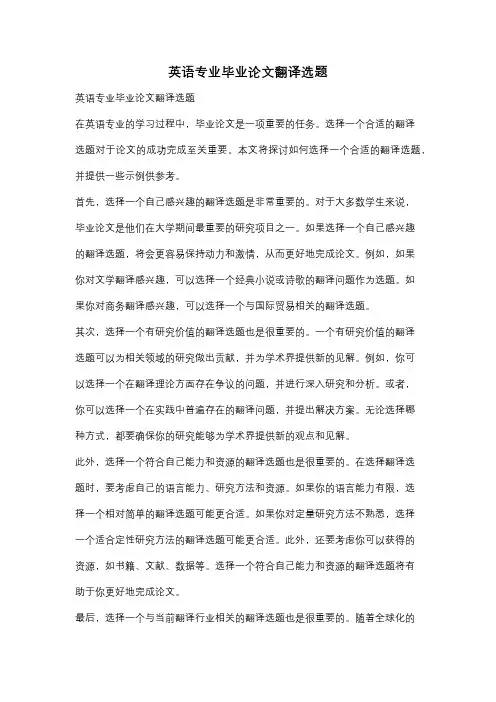
英语专业毕业论文翻译选题英语专业毕业论文翻译选题在英语专业的学习过程中,毕业论文是一项重要的任务。
选择一个合适的翻译选题对于论文的成功完成至关重要。
本文将探讨如何选择一个合适的翻译选题,并提供一些示例供参考。
首先,选择一个自己感兴趣的翻译选题是非常重要的。
对于大多数学生来说,毕业论文是他们在大学期间最重要的研究项目之一。
如果选择一个自己感兴趣的翻译选题,将会更容易保持动力和激情,从而更好地完成论文。
例如,如果你对文学翻译感兴趣,可以选择一个经典小说或诗歌的翻译问题作为选题。
如果你对商务翻译感兴趣,可以选择一个与国际贸易相关的翻译选题。
其次,选择一个有研究价值的翻译选题也是很重要的。
一个有研究价值的翻译选题可以为相关领域的研究做出贡献,并为学术界提供新的见解。
例如,你可以选择一个在翻译理论方面存在争议的问题,并进行深入研究和分析。
或者,你可以选择一个在实践中普遍存在的翻译问题,并提出解决方案。
无论选择哪种方式,都要确保你的研究能够为学术界提供新的观点和见解。
此外,选择一个符合自己能力和资源的翻译选题也是很重要的。
在选择翻译选题时,要考虑自己的语言能力、研究方法和资源。
如果你的语言能力有限,选择一个相对简单的翻译选题可能更合适。
如果你对定量研究方法不熟悉,选择一个适合定性研究方法的翻译选题可能更合适。
此外,还要考虑你可以获得的资源,如书籍、文献、数据等。
选择一个符合自己能力和资源的翻译选题将有助于你更好地完成论文。
最后,选择一个与当前翻译行业相关的翻译选题也是很重要的。
随着全球化的发展,翻译行业正变得越来越重要。
选择一个与当前翻译行业相关的翻译选题将有助于你了解行业的最新发展和趋势。
例如,你可以选择一个与机器翻译或自然语言处理相关的翻译选题,以了解这些新技术对翻译行业的影响。
或者,你可以选择一个与跨文化沟通或语言服务行业相关的翻译选题,以了解这些领域的最新研究和实践。
综上所述,选择一个合适的翻译选题对于英语专业毕业论文的成功完成非常重要。
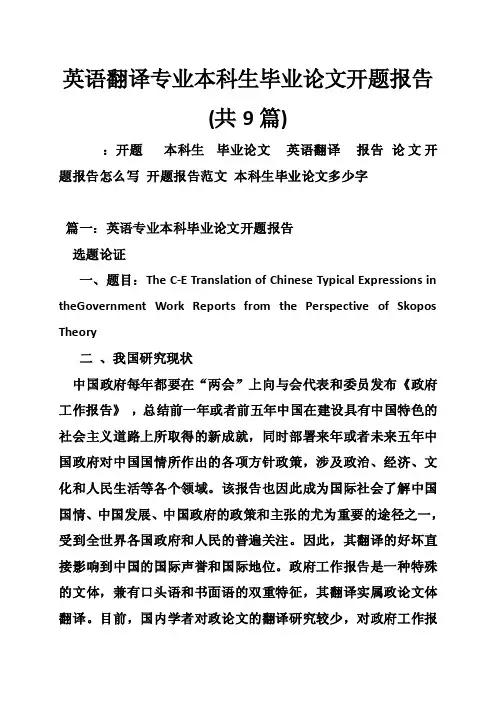
英语翻译专业本科生毕业论文开题报告(共9篇):开题本科生毕业论文英语翻译报告论文开题报告怎么写开题报告范文本科生毕业论文多少字篇一:英语专业本科毕业论文开题报告选题论证一、题目:The C-E Translation of Chinese Typical Expressions in theGovernment Work Reports from the Perspective of Skopos Theory二、我国研究现状中国政府每年都要在“两会”上向与会代表和委员发布《政府工作报告》,总结前一年或者前五年中国在建设具有中国特色的社会主义道路上所取得的新成就,同时部署来年或者未来五年中国政府对中国国情所作出的各项方针政策,涉及政治、经济、文化和人民生活等各个领域。
该报告也因此成为国际社会了解中国国情、中国发展、中国政府的政策和主张的尤为重要的途径之一,受到全世界各国政府和人民的普遍关注。
因此,其翻译的好坏直接影响到中国的国际声誉和国际地位。
政府工作报告是一种特殊的文体,兼有口头语和书面语的双重特征,其翻译实属政论文体翻译。
目前,国内学者对政论文的翻译研究较少,对政府工作报告的翻译更少。
本文作者通过在知网和万方数据中输入关键词搜索关于对政府工作报告中具有中国特色词汇英译研究的书籍、论文、期刊,发现从目的论的角度对政府工作报告中具有中国特色词汇英译进行的研究相对特别少。
本文尝试从功能翻译理论中的目的论的角度对政府工作报告中具有中国特色词汇的英译进行进一步的研究。
三、研究的原因及意义随着对外交流的不断扩大以及中国国际地位的不断提升,《政府工作报告》日益受到世界瞩目,因此该报告的翻译对中国的发展具有深远的影响和重大的意义。
但是《政府工作报告》的翻译难度颇大,因为该报告具有极强的政治性和政策性,对译文的准确性和忠实性要求极高,而且报告中包含了大量的具有中国特色的词汇,很难在英语中找到完全对应的表达方式。
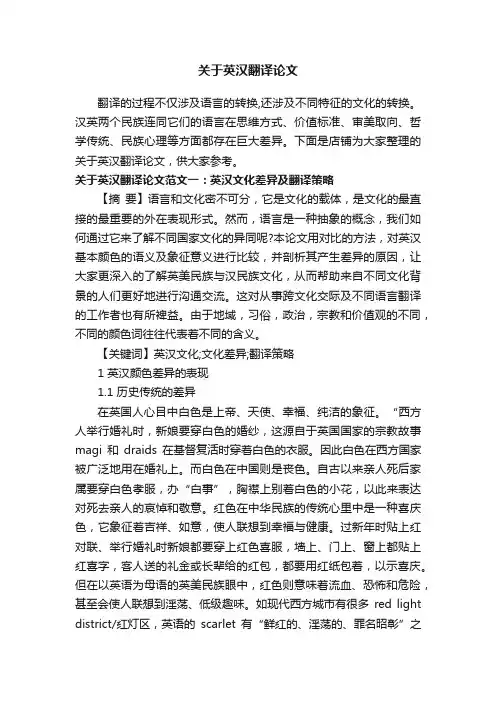
关于英汉翻译论文翻译的过程不仅涉及语言的转换,还涉及不同特征的文化的转换。
汉英两个民族连同它们的语言在思维方式、价值标准、审美取向、哲学传统、民族心理等方面都存在巨大差异。
下面是店铺为大家整理的关于英汉翻译论文,供大家参考。
关于英汉翻译论文范文一:英汉文化差异及翻译策略【摘要】语言和文化密不可分,它是文化的载体,是文化的最直接的最重要的外在表现形式。
然而,语言是一种抽象的概念,我们如何通过它来了解不同国家文化的异同呢?本论文用对比的方法,对英汉基本颜色的语义及象征意义进行比较,并剖析其产生差异的原因,让大家更深入的了解英美民族与汉民族文化,从而帮助来自不同文化背景的人们更好地进行沟通交流。
这对从事跨文化交际及不同语言翻译的工作者也有所裨益。
由于地域,习俗,政治,宗教和价值观的不同,不同的颜色词往往代表着不同的含义。
【关键词】英汉文化;文化差异;翻译策略1 英汉颜色差异的表现1.1 历史传统的差异在英国人心目中白色是上帝、天使、幸福、纯洁的象征。
“西方人举行婚礼时,新娘要穿白色的婚纱,这源自于英国国家的宗教故事magi和draids在基督复活时穿着白色的衣服。
因此白色在西方国家被广泛地用在婚礼上。
而白色在中国则是丧色。
自古以来亲人死后家属要穿白色孝服,办“白事”,胸襟上别着白色的小花,以此来表达对死去亲人的哀悼和敬意。
红色在中华民族的传统心里中是一种喜庆色,它象征着吉祥、如意,使人联想到幸福与健康。
过新年时贴上红对联、举行婚礼时新娘都要穿上红色喜服,墙上、门上、窗上都贴上红喜字,客人送的礼金或长辈给的红包,都要用红纸包着,以示喜庆。
但在以英语为母语的英美民族眼中,红色则意味着流血、恐怖和危险,甚至会使人联想到淫荡、低级趣味。
如现代西方城市有很多red light district/红灯区,英语的scarlet有“鲜红的、淫荡的、罪名昭彰”之意。
由此可见,因历史传统的不同,英汉两民族对待颜色的态度也大相径庭。
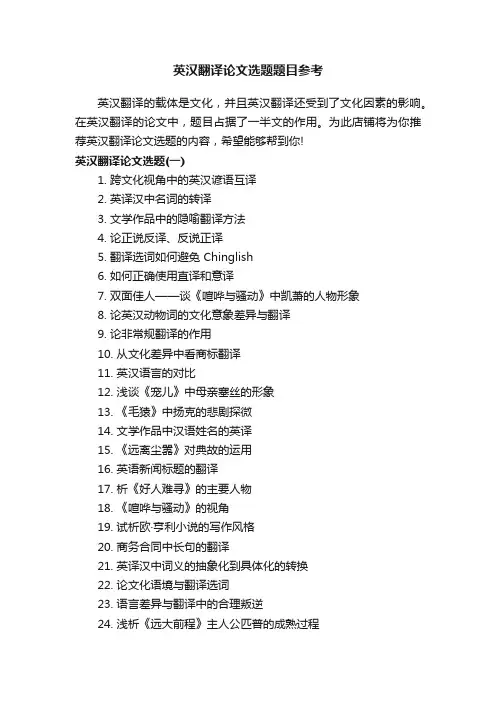
英汉翻译论文选题题目参考英汉翻译的载体是文化,并且英汉翻译还受到了文化因素的影响。
在英汉翻译的论文中,题目占据了一半文的作用。
为此店铺将为你推荐英汉翻译论文选题的内容,希望能够帮到你!英汉翻译论文选题(一)1. 跨文化视角中的英汉谚语互译2. 英译汉中名词的转译3. 文学作品中的隐喻翻译方法4. 论正说反译、反说正译5. 翻译选词如何避免 Chinglish6. 如何正确使用直译和意译7. 双面佳人——谈《喧哗与骚动》中凯萧的人物形象8. 论英汉动物词的文化意象差异与翻译9. 论非常规翻译的作用10. 从文化差异中看商标翻译11. 英汉语言的对比12. 浅谈《宠儿》中母亲塞丝的形象13. 《毛猿》中扬克的悲剧探微14. 文学作品中汉语姓名的英译15. 《远离尘嚣》对典故的运用16. 英语新闻标题的翻译17. 析《好人难寻》的主要人物18. 《喧哗与骚动》的视角19. 试析欧·亨利小说的写作风格20. 商务合同中长句的翻译21. 英译汉中词义的抽象化到具体化的转换22. 论文化语境与翻译选词23. 语言差异与翻译中的合理叛逆24. 浅析《远大前程》主人公匹普的成熟过程25. 论翻译中的中国英语26. 翻译中的英汉文化差异27. 劳伦斯笔下的悲剧性人物保罗英汉翻译论文选题(二)1. 语法翻译法在中学英语教学中的应用2. 中学英语语法课堂多媒体技术运用的优势3. 汉语宣传资料英译探讨4. 体现在中英习语中的文化差异5. 英语学习中对美国俚语的认识6. 电影片名英汉互译的归化与异化及翻译的相关技巧7. 浅析中国英语8. 大卫·科波菲尔中的批判现实主义9. ”信”与英语比喻翻译10. 佩科拉的悲剧探源11. 论凯瑟琳·曼斯菲尔德《园会》中的艺术特色12. 中学英语阅读教学中的文化差异渗透13. 口译中的笔记及实际运用中的障碍14. 浅析委婉语及其语用功效英汉翻译论文选题(三)1. 汉译英中的文化差异——词汇空缺与中国特色文化翻译2. Questioning and Teaching of Reading3. 英汉动物比喻的文化内涵及差异4. (动物比喻在英汉两种文化的内涵及差异)5. 哈代——具有乡土田园气息的作家6. 英语语言中的性别歧视(主义)7. 浅析英语语篇中的词汇衔接8. 浅谈景点名称的英译9. 英汉禁忌语和委婉语对比研究10. 广告翻译中的修辞手法11. 不同语境中的翻译12. 直译与意译13. 浅谈中国式英语的现象14. 英汉翻译中文化特性的处理15. 英汉谚语比较16. 英文广告中双关语及其翻译17. 商标翻译中的文化因素18. 英美文化差异与颜色词的翻译19. 论英语俚语的汉译。
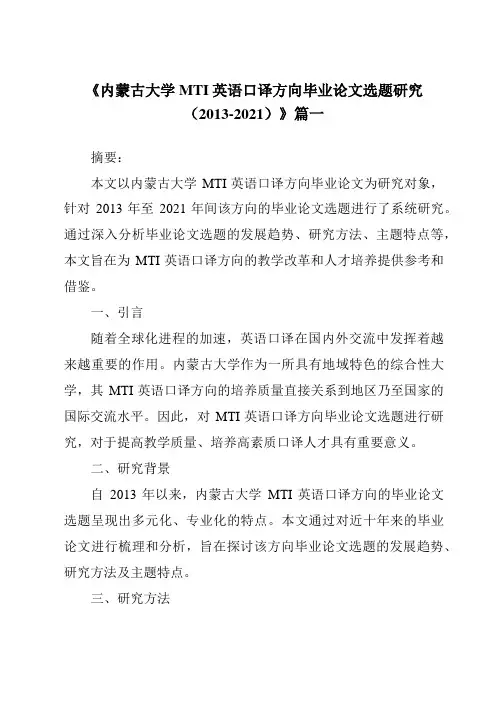
《内蒙古大学MTI英语口译方向毕业论文选题研究(2013-2021)》篇一摘要:本文以内蒙古大学MTI英语口译方向毕业论文为研究对象,针对2013年至2021年间该方向的毕业论文选题进行了系统研究。
通过深入分析毕业论文选题的发展趋势、研究方法、主题特点等,本文旨在为MTI英语口译方向的教学改革和人才培养提供参考和借鉴。
一、引言随着全球化进程的加速,英语口译在国内外交流中发挥着越来越重要的作用。
内蒙古大学作为一所具有地域特色的综合性大学,其MTI英语口译方向的培养质量直接关系到地区乃至国家的国际交流水平。
因此,对MTI英语口译方向毕业论文选题进行研究,对于提高教学质量、培养高素质口译人才具有重要意义。
二、研究背景自2013年以来,内蒙古大学MTI英语口译方向的毕业论文选题呈现出多元化、专业化的特点。
本文通过对近十年来的毕业论文进行梳理和分析,旨在探讨该方向毕业论文选题的发展趋势、研究方法及主题特点。
三、研究方法本文采用文献分析法、内容分析法及案例分析法等方法,对内蒙古大学MTI英语口译方向毕业论文选题进行系统研究。
通过收集近十年来的毕业论文,对论文的选题趋势、研究方法、主题特点等方面进行深入分析。
四、毕业论文选题发展趋势(一)选题趋势分析自2013年以来,内蒙古大学MTI英语口译方向的毕业论文选题呈现出多元化、专业化的特点。
从研究领域来看,涉及政治、经济、文化、教育等多个领域;从研究方法来看,采用实证研究、理论研究等多种方法;从主题特点来看,关注时事热点、地域特色等。
这些特点表明,该方向的毕业论文选题在不断发展和完善。
(二)地域特色在选题中的体现内蒙古大学地处我国西部地区,具有丰富的地域文化特色。
在MTI英语口译方向的毕业论文中,充分体现了对地域特色的关注和探讨。
例如,对内蒙古地区的民族文化、经济发展、旅游推广等领域的口译实践和研究。
五、主题特点分析(一)政治经济类主题政治经济类主题是MTI英语口译方向毕业论文的重要研究方向之一。
关于英语翻译方向的论文范文翻译在跨文化、跨民族之间的交流和合作中功不可没,英语翻译,它既是语言之间的相互转换,同时也是不同文化间的交流。
下文是店铺为大家整理的英语翻译的论文的范文,欢迎大家阅读参考!英语翻译的论文篇1文化空缺与英汉翻译摘要:不同民族的语言产生于不同的文化背景,所承载的文化也不尽相同,这就必然导致两种语言在表达方式上存在很多相异之处,文化空缺就是这些差异的极端表现,它是一个民族语言和文化与其它民族语言和文化的异质性的充分体现,这无疑增加了翻译的难度。
所以文化空缺的翻译不仅是语言的迁移,更是文化的传播。
关键词:文化空缺英汉翻译翻译作为人类最早进行的交流活动之一,一直在不同的语言集团间沟通信息,对人类社会的发展和进步有非常重要的作用。
正是由于翻译所起的中介作用,民族间才可以互通有无、互相学习、共同发展。
跨文化交际学和文化语言学的兴起与发展,为语言与文化的研究带来了勃勃生机。
而作为跨文化交际的翻译,也因此而更加受到重视,对它的研究也呈现出多角度、多侧面、开放性的特点。
翻译作为不同语言之间人们交流思想和文化不可或缺的手段,在传播文化信息、促进不同民族间的相互了解与民族融合的过程中的重要作用已日益凸显。
翻译界对翻译理论研究的重心从译意到译信息再到以文化为导向的翻译,正说明翻译实质是文化的翻译。
如Bassnet & Lefevele就指出翻译的研究实际上就是文化互动的研究,Nida亦强调译者的双文化能力。
而在交流与翻译活动过程中,各民族由于语言文化异质性的客观存在,会不可避免地出现信息交流的障碍。
其中作为语言文化异质性极致体现形式的文化空缺现象更使交流者进入了两难的境地。
为积极应对空缺现象带来的问题,促使交流与翻译的顺利进行,就必须在交流与翻译过程中逐步探寻处理文化空缺的有效途径和办法。
翻译,在古时候叫做“象寄”或“通事”。
《说文解字》里说:“传译四夷之言者。
”《义疏》里也提到:“译即易,谓换易言语使相解也。
【关键字】论文English Novel Title Translation: A Skopostheorie Perspective英语小说标题的翻译:一个Skopostheorie透视图The Translation of Fuzziness in the Dialogue of Fortress Besieged from the Perspective of Relevance Theory翻译的模糊性的对话《围城》从关联理论的角度On Domestication Strategy in Advertisement Slogan Translation在归化策略在广告口号的翻译Reproduction of “Three Beauties” in the Translation of the Poems in The Journey to the West繁殖的“三美”翻译的诗歌在西游记A Comparative Study of Interjection Translation in Teahouse from the Perspective of Functional Equivalence一个比较研究,在茶馆的感叹词翻译功能对等的角度Public Signs Translation from the Perspective of Functionalist Theory -- as an Example公共标志的翻译的角度,从实用主义的理论——以邵阳城市作为一个例子The Application of Skopostheory in the Business Advertisement TranslationSkopostheory的应用在商业广告翻译Relevance Theory Applied in the Translation of Neologism关联理论应用于翻译的新词Domestication and Foreignization in the Translation of Tourist Texts归化和异化在翻译旅游文本A Comparative Study of the Two English Versions of Lun Y u by James Legge and Ku Hongming from Translator's Subjectivity一个比较研究的两个英文版本的Lun Yu詹姆斯Legge和Ku Hongming从译者的主体性On the Translation and Functions of Metaphor in Advertisements在翻译和函数中隐喻的广告C-E Translation of Film Titles from the Perspective of Adaptation Theory汉英翻译的电影片名的角度,从适应理论Pun Advertisements Translation From the Perspective of Adaptation Theory广告双关语翻译的角度,从适应理论Analysis of the Translation Strategies of the Culture-loading Words in the English Version of Journey to the West分析的翻译策略在英语文化加载字版的西游记On Business Letter Translation under the Guidance of Conversational Implicature Theory在商务信函翻译的指导下,会话含义理论On the Translation of Puns in English Advertising在翻译双关语在英语广告Advertising Translation in the View of Skopos Theory广告翻译目的论的观点A study on Trademark Translation from the Perspective of Reception Aesthetics商标翻译的研究从接受美学的角度On the Audio-visual Subtitle Translation of Kung Fu Panda 2 from Skopostheorie Perspective在视听影视字幕翻译的《功夫熊猫2》从Skopostheorie透视图Cooperative Principle and Negative-information Business Letters合作原则和负面信息商务信函On Influence of Chinese Culture on Imagism of America—A Case Study of Pound’s Poems在中国文化的影响在美国意象派——案例研究庞德的诗歌The Translation of English Animal Idioms in the Perspective of Pragmatic Equivalence英语动物习语的翻译的语用等效的角度On the Improvement of English-Chinese Interpretation from the Perspective of Comprehension and MemoryOn Creative Treason and Its Relationship with Fidelity in Literary Translation在创造性叛逆和它的关系,文学翻译中忠实A Brief Look into Conceptual Metaphor—A Case Study of the Poems Selected from A Dream of Red Mansions一个简短的调查概念隐喻一个案例研究的诗歌选自《红楼梦》The Translation of Subtitles in "Desperate Housewives" from the Perspective of Functional Equivalence字幕的翻译在“绝望的主妇”从功能对等的角度An Analysis of Shi Xiaojing’s Translation of Camel Xiangzi Based on Reception Theory施小菁的分析翻译的骆驼祥子》基于接受理论A Study on Zhang Peiji's Translation of Modern Chinese Prosefrom the Perspective of Translator's Subjectivity研究张Peiji现代汉语Prosefrom翻译的译者主体性的视角The Translation of Wang Wei's Works From the Perspective of"Three Beauties" Principle王伟的翻译作品的角度,从“三美”原则English Passive Voice and Its Application to Translation英语主动语态和它的应用程序来翻译Metaphor Translation from the Perspective of Aesthetics--A Case Study of the English Version of Li Bai’s Poems隐喻的翻译从美学角度出发,一个案例研究的英语版本的李白的诗Domestication and Foreignization in Allusion Translation in Hongloumeng归化和异化的翻译在Hongloumeng典故English Translation of Hunan Tour Commentary from the Perspective of Intercultural Communication英语翻译的湖南旅游解说的角度,从跨文化交流The Application of Functional Equivalence Theory in Chinese-English Lyric Translation应用程序的功能对等理论对汉英翻译歌词On the Cultural Discrepancies of Color Terms Between English and Chinese and Their Corresponding Translating Strategies在文化差异的英语和汉语之间的颜色词及其相应的翻译策略On the Style of Zhang Peiji's Prose Translation在张的风格的散文翻译PeijiA Functionalist Approach to Advertising Translation一个实用主义的方法对广告翻译C-E Business Contract Translation under the Guidance of Skopos TheoryOn Allusion Translation under the Guidance of Relevance Theory---A Case from Lin Yutang's Six Chapters of a Floating Life 在典故翻译的指导下,关联理论———案例从林语堂的六章的一个浮动的生活A Study on C-E Trademark Translation from the Perspective of Cultural DifferencesOn Violation of Cooperative Principle in Subtitle Translation of Ice AgeOn the English Translation of Hunan Cuisine from cultural AspectsOn the Feasibility of "Three Beauties" Principle in Tang Poetry TranslationOn the Translation of Subjects in Chinese-English TranslationOn the Translation Strategies of Lang Tuteng from the Perspective of Domestication andForeignizationMetaphor Translation from the Perspective of Relevance TheoryBeauty of Chinese in Translated Lyrics of the English Pop SongsThe Different Styles of Translation in Rush: From the Choice of WordsTranslation of Scenery Description in Tourist Text in Hunan in Cross-culture CommunicationOn E-C Translation of Puns in Advertising from the Perspective of SkopostheorieE-C Translation of Cartoon Subtitle from the Perspective of Skopostheorie——A Case Study of Ic e AgeOn C-E Translation of Scenery Spots Introduction in Hunan Province from Cultural PerspectiveDomestication and Foreignization in C-E Translation of Four-Character Idioms On C-E Translation of Hotel Introduction in Hunan Province from the Perspective of SkopostheorieE-C Translation of Business Letters—From the Perspective of Nida’s Functional Equivalence TheoryA Skopos Study on the Translation of Report on the Work of the Government 2011On English-Chinese Translation of Business Correspondence from the Perspective of Skopos TheoryUniversals of Translation and Zhang Peiji's Selected Modern Chinese ProseOn Xu Yanchong’s Translation of 300 Tang Poems from the Perspective of Aesthetics Reception TheoryOn Subtitles Translation of Humorous Dialogues in Friends from the Perspective of Functional EquivalenceAn Elementary Study on Chinese to English Soft News Translation: from the Perspective of Nida's Functional-Equivalence Translation TheoryAn Elementary Study on Brand Name Translation--from the Perspective of Peter Newmark's Communicative Translation TheoryA Study on Gu Zhengkun's Translation of Shakespeare's Sonnets-- from the Perspective of SkopostheorieApplication of the Functionalist Translation Theory in Film Title TranslationA Study on the Translation of Idioms Between English and Chinese from the Perspective of Functional EquivalenceA Study of Chinese Menu Translation from the Perspective of Foreignization and Domestication On Translation of Brand Names from the Perspective of AdaptationOn English Translation of Li Bai’s peotry in the Light of Functional Equivalence Theory The “Equivalence” and “Aestheticism” in Trademark TranslationOn Culturally Loaded English Idioms and Their Translation此文档是由网络收集并进行重新排版整理.word可编辑版本!。
关于英语翻译方向的论文范文(2)英语翻译的论文篇3浅谈职业教育商务英语翻译人才的培养模式0 前言目前对商务英语的培养我们主要是以相关的课程辅导为主,比如说“商务英语翻译”主要阐述的是一些国家的基本的商务模式,以及语言习惯问题,主要是提高人才的商务能力和翻译能力,保障商务英语专业人才能够正确传达客户之间的交流信息,保障双方的利益。
然而由于长期受传统的培养模式的影响,商务英语人才的培养并没有那么容易。
基于这种情况,研究出一套好的商务英语翻译人才培养的方案是很重要的。
1 商务英语人才在培养过程中常见的一些问题以及解决方法就目前而言主要有下列一些问题:人才在培养的过程中教学知识太过于宽泛,缺乏职业的明确性,没有很强的职业观念。
另一类问题就是在教学的过程中太过于书面化缺少实践的锻炼,同时在人才的考核方面也存在很多缺陷,例如考核的标准太过于单一缺少综合性的体现。
这些都是目前所存在的一些问题,针对这些问题我们提出了一些相对应的措施:首先是加强职业观念的培养,要能够做到专业与职业对口,其次就是要加强实践的力度,可以把一些基本的工作任务分配给学生作为教学的主要内容。
最后就是在人才的考核过程中,我们要实现考核的多样化,提高考核的标准,让能力优先者能够有一个好的平台发挥自己的能力。
1.1 人才培养模式的构建人才的培养最终是服务社会的,所以说在人才培养模式的构建过程中我们需要时刻关注社会的动态与走向,以便培养出来的人才能够更好地服务于社会。
人才培养模式的构建需要我们教师通过多年的教学经验和方法的总结才能构建出来的,长时间地比较各种方法,最后留下高效有用的学习方法。
人才培养模式的构建是需要教育者一起来共同努力的。
在培养的过程中我们要以学生为中心,主要是围绕学生展开一系列的教学活动,力求学生能够在短时间内能够学到大量有用的知识。
以职业能力的培养为主导思想,定义专业的能力标准。
教学主要是以实践任务为主,旨在提高人才的职业能力。
“论文学翻译过程”“语义翻译和交际翻译理论在英汉翻译中的运用”“英语句子成分的省略及汉译”“文学翻译中隐喻的传译”一、选题范围1、翻译与文化:可以从宏观和微观两个方面考虑。
宏观方面,一般从翻译在目的语社会文化中的生产、接受、翻译在目的语社会文化中所起的功能等角度讨论,可以从社会、文化、历史、交际的视角切入。
阐述为什么有那样的译文?如严复的翻译,林纾的翻译,傅东华翻译《漂》时为什么使用归化的手段,鲁迅翻译的策略,翻译材料的选择等等。
微观方面,可以讨论语言文字所承载的文化内容和内涵如何在翻译中表达,如文化负载词的翻译策略等。
2、翻译与语言学理论:可以从篇章语言学,功能语言学(如喊韩礼德的系统功能理论等),对比语言学,心理语言学,交际语言学、文化语言学等方面考虑选题。
如功能语言学和篇章语言学中讨论的衔接与连贯及其翻译,也可以讨论他们在英语和汉语中的差别入手,进一步讨论他们在翻译中的处理,主位、述位的推进极其在翻译中的体现。
英语汉语对比及其翻译策略等等。
3、翻译与语文学。
主要从艺术的角度讨论文学翻译中的问题。
4、应用翻译:主要从特殊用途英语如商务英语、科技英语、旅游英语等方面讨论在这些特殊领域中涉及的翻译问题如何处理。
如旅游宣传资料的翻译等。
5、译文对比:可以是同一篇文章、同一本书,不同的译者在同以时期或不同时期进行的翻译做的对比,也可以是同一个译者对同一篇文章或书在不同时期的翻译的对比;可以是翻译技巧等微观层面的对比,也可以是宏观曾面的对比,以探索为什么在不同时期译者回采取不同的策略,有哪些社会的、文化的、政治的、意识形态的原因?6、翻译及评论:首先选择一篇长文,一般是文学作品且没有人翻译过,进行翻译,翻译完后,从上述五个方面选择一个理论视角对自己的翻译进行评论。
7、译者风格。
8、翻译与美学。
二、选题方法:上述各个方面均可写出几本甚至几十本专著,因此大家从上述方面可以选出一个写作的范围。
缩小选题范围:首先是广泛浏览上述各有关方面翻译研究资料,以确定自己对哪方面感兴趣且有话可说,这是缩小范围的第一步。
翻译类论文开题报告模板范文一、选题背景与意义翻译是文化交流的重要方式之一,对于促进不同国家和地区之间的交流与合作具有重要作用。
随着全球化的不断发展,跨国交流与合作日益增加,翻译的需求也呈现出多样化和专业化的趋势。
然而,在翻译过程中,常常会遇到词语的多义性、文化差异以及语言特点等问题,对于翻译人员来说,这些问题都是需要重视和解决的。
因此,本论文的选题目的在于探索在翻译过程中遇到的难题,并提供相应的解决方案和建议,以提高翻译质量和效率,满足不同领域翻译的需求。
二、研究目标本论文的研究目标可以细分为以下几个方面:1.分析翻译过程中词语的多义性对翻译质量的影响,并提出相应的解决方案。
2.探讨翻译过程中存在的文化差异问题,研究如何更好地处理这些差异以提高翻译效果。
3.研究不同语言的语言特点对翻译过程的影响,探索如何利用语言特点进行准确翻译。
4.分析翻译过程中的机器翻译技术,并研究如何将其与人工翻译相结合,提高翻译效率。
三、研究方法与论文结构本论文将采用文献综述和实证研究相结合的方法进行探究。
首先,通过对相关文献的查阅和分析,总结翻译过程中常见的问题及其解决方案。
然后,进行实证研究,选取一些具体的翻译任务,对比不同的翻译方法和策略,评估其效果和可行性。
论文的结构将按以下顺序展开:1.引言:介绍翻译的重要性和研究背景,说明选题的意义和目标。
2.相关理论综述:对翻译过程中的常见问题和解决方案进行综述,分析现有研究成果和方法。
3.研究方法:详细介绍研究的方法和步骤,包括文献综述和实证研究的设计与实施。
4.实证研究结果与分析:对实证研究的结果进行统计和分析,评估不同方法和策略的效果。
5.结果讨论与展望:对研究结果进行讨论和总结,提出对未来研究方向的展望。
6.结论:对全文进行总结,并提出研究的局限性和改进建议。
四、论文进度安排本论文的完成预计需要以下几个阶段:1.研究背景与选题(一个月):对翻译的背景进行深入了解,确定研究的需求和目标。
跟翻译有关的英语作文Title: The Importance of Translation in Global Communication。
Translation plays a pivotal role in global communication, facilitating the exchange of ideas, cultures, and commerce across linguistic boundaries. In anincreasingly interconnected world, the significance of translation cannot be overstated. This essay explores the multifaceted importance of translation, touching upon its role in diplomacy, literature, business, and fosteringcross-cultural understanding.Firstly, translation serves as a vital tool indiplomatic communication. In international relations, accurate translation of official documents, treaties, and speeches is indispensable for maintaining diplomatic relations between nations. A minor error in translation could lead to significant misunderstandings or even diplomatic crises. For instance, a mistranslation in atreaty could result in legal disputes or strained relations between countries. Therefore, skilled translators with a deep understanding of both languages and cultures are essential for effective diplomacy.Moreover, translation plays a crucial role in the dissemination of literature and knowledge across borders. Many literary masterpieces, scientific texts, and philosophical works have been translated into multiple languages, allowing people from diverse linguistic backgrounds to access them. Translators not only convey the words but also the nuances, cultural references, andliterary styles of the original work, ensuring that the essence of the text is preserved. Without translation, literary treasures from different cultures would remain inaccessible to a large portion of the global population.In the realm of business, translation facilitates international trade and commerce. Companies seeking to expand into foreign markets rely on translation services to localize their products, marketing materials, and websites. Effective translation enables businesses to communicatewith customers in their native languages, enhancingcustomer engagement and boosting sales. Additionally, accurate translation of contracts, agreements, and business correspondence is essential for conducting smooth transactions and building trust with international partners.Furthermore, translation plays a crucial role in fostering cross-cultural understanding and promoting tolerance. By making works of literature, films, and other forms of cultural expression accessible to people worldwide, translation promotes empathy and appreciation for different cultures. Through translated literature, readers can gain insights into the customs, beliefs, and values of societies different from their own, breaking down stereotypes and promoting mutual respect. In an increasingly multicultural world, translation serves as a bridge that connects people from diverse backgrounds, fostering dialogue and cooperation.Despite its significance, translation poses several challenges. Translating idiomatic expressions, cultural references, and linguistic nuances accurately requires notonly linguistic proficiency but also cultural sensitivity and contextual understanding. Moreover, the ambiguity of certain words or phrases in one language may not have an exact equivalent in another, making translation a complex and sometimes subjective endeavor. Additionally, machine translation tools, while increasingly sophisticated, still struggle to capture the subtleties of human language and cultural nuances.In conclusion, translation is an indispensable tool for facilitating global communication and fostering cross-cultural understanding. From diplomacy and literature to business and everyday communication, translation enables people from different linguistic backgrounds to connect and engage with one another. While it presents challenges, the benefits of translation in promoting mutual understanding and cultural exchange far outweigh the difficulties. As our world becomes more interconnected, the role of translation in bridging linguistic and cultural divides will only grow in importance.。
翻译方向毕业论文选题汇总The Semantic Contrast of Color Words between English and Chinese and中英颜色词的语义对比及翻译Chinese Reduplicated Words and their Translation into E汉语叠词及其英译Brand Translation商标翻译On Translating Methods of Numerals between Chinese and English中Literal and Free Translation in the Translation of Advertisement Hea广告用语的直译和意译On the Translation of Chinese Trade Mark into Engli中文商标的英译Culture Differences and Translation文化差异和翻译Charactecistics and Translation of Adventisement广告英语的特征及其翻译Principles and Methods on Brand-Translation商标翻译的原则和方法The Study on Features of Advertising and its Translation 广告语Non-Correspondence in English-Chinese Translation of Color Words中英文A Study on the Translation of Movie Titles电影片名的翻译On the Cultural Signification of Animal Idioms and Tran动物俚语文化含义与翻译The Translation of Color Terms试论颜色词的翻译A comparative Study of the Old Man and the Sea---Concerning the Perfectio《老人与海》译文比较-谈影响文学翻译完美性的因素On the Translation of Advertisement ――From the Perspective Of Fun从功能派理论角度看广告翻译Influence of Cultural Differences on Translation of Idioms文化Foreignizing and Domesticating Translations in Cross-cultur跨文化视野中的异化和归化翻译The Subject and Topic in Chinese-English Translation S汉译英中的主位与话题The Loss of Affective Meaning in Translation ―from the Perspective o从文化差异的角度看翻译中情感意义的丢失On the Explicitness and Implicitness of Conjunctions in English-Chines论连词再英汉翻译中的显性和隐性存在Approaching Domestication and Foreignization in Translation from a Fu从功能翻译角度看归化与异化On Translation of Idioms论习语的翻译Translation of Chinese Receipts and the Differences of Cookery Culture between Chin中餐菜谱的英译及中西饮食文化差异On the Untranslatability due to Cultural Difference不可译现象在中英文化差异中的体现Extra-linguistic Context and Translation非语言语境与翻译Comparison and Translation of Chinese and English Idi汉英习语对比与翻译On Translation of Chinese and English Idioms from Cultural P从文化的角度谈英汉习语的翻译Cultural Differences Between English and Chinese Idiom中英文习语翻译中的文化差异比较Impact of Culture Differences on Brand Translation of TrademarksCultural Context and The Translation of Metaphors文化语境和隐喻的翻译Conversion of Part of Speech in English-Chinese TranslationForeignizing and Domesticating strategies in Cross-cul Translation文化翻译中的异化与归化策略A Study of the Chinese-English Translation of TrademarksHow To deal with culture-loaded words in idioms transl习语翻译中文化词的处理Cultural Connotation and Translation for Color Word颜色词的文化内涵与翻译The Translation of English Loanwords into Chinese英语外来词汉化的基本途径When in Rome do as the Romans do——On translation of Chinese trade入乡随俗——论中文商标的英译Cultural differences and Translation between Chinese and English Idioms汉Foreignization In Translation in the 21st in China21世纪中国的异化翻译The Transfer of Culture Image and of English and Chinese Idioms论英汉习语翻译中的文化意象的转化Basic Strategy for Advertisement Translation-Target-language Ori广告翻译的基本策略--以目的语言为取向的翻译策略Lexical Rhetorical Devices in English-Chinese Transla英汉翻译中的词义修辞格The Criteria of the Translation of Computer Englis计算机英语的翻译标准Comprehension: A Very Important Part of Translatio理解:翻译中不可或缺的一部分The Translation of the Brand Name商标名称的翻译Strategies for Translationg English Slang into Chine英语俚语汉译的技巧Cultural Factors in the Translation of Poems诗歌翻译中的文化因素Cultural Differences and the Translation of Brand Na文化差异与商标翻译Cultural Differences and Untranslatability文化差异和不可译性Cultural Differences and Vocabulary Translation文化差异及词汇翻译The Application of Fuzziness in the Translation翻译中的模糊语现象Translator as Artist -Translator's Individuality in Literary译者作为一位艺术家--论文学翻译中的译者个性The Translation of Movie Titles电影名的翻译Translating the English Verbs into Chinese译Colour Words and the Translation颜色词及其翻译Domestication and Foreignizationin The Book of Songs诗经翻译的归化和异化Cultural Comparison and Idioms Translation文化对比与习语的翻译Social-cultural Context and the Translator’s Choice WordsVersions of Jane Eyre社会文化背景和译者的选词——对简爱两种译本的比较The Effect That Non-linguistic Context Has on Transla非语言语境在翻译中的作用Cultural Gaps between English and ChineseIdioms and Their Translation英汉习语的文化差异及其翻译Words Translation between Different Cultures文化中词汇的翻译On Cultural Differences and Idiom Translation文化差异与习语翻译On Translation of English Trademarks Into Chinese----On Beauty I浅谈英文商标的汉译--意美、音美、形美Some of the Ways to Idiom Translation 习语翻译法Paralanguage and Literature Translation -With Reflections on the Version副语言与文学翻译--对《红楼梦》译本的思考Methods of Translating Color Words Based on Cultural Differences betweeCulture-gap Words and the Translation文化空缺词及其翻译Understanding-the Key to Translation理解是翻译的关键A Brief Talk about Two Approaches to the Translation of Metaphor浅谈A Glimpse of English Film Title Translation英语电影名翻译一瞥Social-cultural Differences and the Translator’s Choice社会文化差异与译者的选词The Application of Domestication and Foreignization in the Transla文化翻译中归化与异化的应用Cultural Differences and Untranslatability文化差异与不可译性The Context in Relation to Translation语境与翻译Female and Translation女性与翻译Effects of Difference between the Chinese and Western Cultures中西文化差异对于翻译的影响The Cultural Differences and Translation of English and Chin英汉习语的文化差异与翻译Cultural Gaps and Translation Limitation文化差异与翻译局限The Approaches to Proverb Translation in Cultural Context从文化Allusion Translation in Song Poems宋词典故的翻译Blind Spots in English Proverbs Translation英谚汉译中的盲点的探讨Advertisement Translation广告翻译Differences Between Chinese Headline and English Headline aswell as论中英文新闻标题的差异与翻译On the Mistranslation of Idioms习语的误译The influence of Culture onthe Translation of Advertise文化对广告翻译的影响On English Idioms and Their Translation英语习用语的翻译On the Translation Strategy of Chinese Classics ----With Special Reference to Arthur Waley’s English Version o浅谈中国典籍的翻译策略----从阿瑟•威利的《论语》译本悟其翻译之道Cultural Differences and Untranslatability文化差异与不可译性Unveil the Cultural Elements of English --On the Translation of揭开英语中文化因子的面纱——浅谈英语习语的翻译Adaptation And Alienation in Intercultural Translati跨文化翻译中的归化与异化Cultural Connotation and Translation of E-C Animal Wo英汉动物词的文化内涵及翻译A Brief Talk on Trademarks Translation浅谈商标翻译On the Translation of English and Chinese Proverbs from the Perspective of I从跨文化交际角度谈英汉谚语翻译Cross-cultural Awareness in Translating Tourist Materials from Chi中文旅游资料英译的跨文化意识Connotative Comparison and Translation of Chinese “Hong” and论中英文红色内涵意义对比及其翻译方法On the Principles of Equivalence in the Translation of English Idioms into Chinese英语成语翻译中的对等原则及具体应用Translation of Animal Words动物词语的翻译On Cultural Factors in English and Chinese Trademark Translation and Fo英汉商标翻译中的文化因素及四种翻译方法On the Comprehension and Translation of English Prove论英语谚语的理解与翻译The Influence of Christian Culture on Translation基督教文化对翻译的影响Cultural Differences and Idiom Translation文化差异和成语翻译The Subjectivity of the Translator in Literary Translatio文学翻译中的译者主体性How to Teach English in Communicative Way in Middle SchoolCultural Differences and Transplantation in Translat文化差异和翻译中的文化移植Translation of English Advertisement under Aesthetic Principl英语广告翻译与修辞格美学原则A Study on the Translation of the English Idioms关于英语习语翻译的研究The Influence of Feminism on Translation女性主义对翻译的影响On the Role of Context in Literal Translation and Free Translation谈语The Cultural Differences and Translation of English & Chine英汉习语的文化差异与翻译On the Differences between Eastern and Western Cultures Viewed From P从英汉谚语翻译看东西方文化的差异Idioms’ Practice and Translation in Advertising习语在广告中的应用与翻译On Translating English Movie Titles into Chinese浅谈英语电影片名的汉译Application of Functional Equivalence in Translating Engl功能对等理论在翻译英语幽默中的运用On the Impact of Translation on Chinese Culture--- To Cherish Chinese Cu翻译对中国文化的影响 --- 保护中国文化On the Role of Negation in Translation正反表达在翻译中的作用The Importance of Cultural Factors in Translation翻译中文化因素的重要性Probing the Translation of Classical Chinese Poems from the Perspectiv"从"三美"的角度探究中国古典诗歌之英译Cultural Differences and Translation of English Idiom文化差异与英语习语的翻译Cultural Strategies for CE/EC Proverb Translation: Domestication a英汉谚语互译的文化策略:归化与异化A Comparative Study of Two English Versions of One of Tao Yuanming’s对陶渊明《饮酒》组诗之一的两个英译本的比较研究A Brief Discussion Of the Active Role of the Translation Subject 翻译主体能Cultural Aphasia in C-E Translation of Brand Names商标英译中的文化失语现象A Brief Talk about Some of the Skills Used in Advertisement Tr浅谈广告翻译中的某些技巧Strategies for Movie Subtitling电影字幕翻译的策略On the Transplantation and Translation of Brand Name from Chines中文商标英译的文化移植The Characteristics, Culture Differences of Idioms and the T习语的特点和文化差异及其翻译Intercultural Communication in Translation of Brand N商标翻译中的跨文化交流On the Thranslation of English Set Phrases with Cultural Feature论带有文化特征的英语成语的翻译The Translation of Chinese Idioms into English汉语习语的英译The Effect of Different Culture on IdiomTranslatio文化差异对习语翻译的影响On The Translation Of Tourist Brochures -----From The Perspective O目的性理论与旅游手册的翻译Public Visual Threshold’s Limitation to Translatio公共视域对翻译解释的限制性Translating the Style of Literary Works – A Preliminary Study of Dong Qiusi’s文学作品的风格翻译–董秋斯译〈大卫科波菲尔〉初探On Culture Differences in English-Chinese Translati论英汉翻译中的文化差异On the Cultural Differences in Translation Viewed from Tou从旅游文本探究翻译中的中西文化差异Metaphor Phrase -- Culture Factors and Translation隐喻性词语的文化因素及其翻译A Brief Talk about Chinese Body-related idioms and Their Tr浅谈含人体部位词的成语翻译A Brief Talk about the Relationship between Hypotaxis and Parataxi浅谈翻译中形合与意合的关系Analysis on the translation of polysemous wordsChinese-English Translation of Public Signs from the Perspective从目的论角度看公示语的汉英翻译Cultural Default and Translation文化缺省与翻译Cultural Factors in Translation and Their Negative Tra翻译中的文化因素及其负迁移Non-equivalence at Word Level and Strategies For Translat英汉互译中的词汇不对等及其翻译策略Lin Yutang’s Views on TranslationNon-equivalence at Word Level and Strategies For Translat英汉互译中的词汇不对等及其翻译策略On Application of Skopostheories in Film Title Translation的运用On comprehension and translation of the figurative versions论英译汉中On Cultural Context and Translation文化语境与翻译On Cultural Features in Costume Advertisement Transla论服装广告翻译中的文化特征On Features and Translation of English News Headlin英语新闻标题的特点与翻译On Free Translation Used in Film Caption中的意译On Linguistic and Cultural Factors Affecting Comprehension in Translation论翻译中影响理解的语言和文化因素On the Adaptation and Alienation of the Idiom Translation论习语翻译中的归化和异化On the Alienation in Translation论翻译中的异化On the Character and Translation of News HeadlinesOn the English Versions of Some of Li Bai’s Poems译On the Linguistic Features of Long Sentences in EST and Translat论科技英语长句的语言特征及翻译技巧On The Role Of Word Conversion In Translation换的作用On the Strategies of Translating English Passive Sentences i英语被动句的汉译策略On English Translation of Public Signs谈公示语的英语翻译On Translating the Allusions in Six Chapters of a Floating Life: an Int从互文性角度看《浮生六记》中的典故翻译On Word Class Conversion in EST Translation科技英语翻译中的词类转换Syntactical Differences Between English and Chinese and Techniques for Translating En英汉句法差异和英语长句的汉译The Cultural Connotation of Numbers and Translation Stra论数字的文化内涵与翻译策略The Effect of Readers on Translation读者在翻译中的作用The Principles and Strategies of Advertising TranslationThe Proper Disposal of News Translation from Chinese to English 汉语Translation and Ethical Norms翻译与伦理规范The Application and Translation of Figure of Speech in English广告中的比喻及其翻译The Affirmation and Negation in English-Chinese Transl英汉互译中的正译和反译On Untranslatability between English and Chinese and Strategies for Their Tran英汉互译中的不可译性及其转化策略On the Semantic Gaps between English and Chinese and Their Transl英汉语义空缺现象及其翻译策略On the Usage of Negation in E-C Translation论英译汉中反译法的使用A Tentative Study on The Translation of English Movie T经典英文电影片子名翻译Person and tense in translation of Ancient chinese poems a中国古诗词英译中的人称和时态On the Translation of Numeral Fuzziness翻译中数词的模糊性The Translation of Names of Places in English and Chinese浅谈英汉俗语中的地名翻译Translation of Scientific and Technical Termologie科技术语的翻译Pragmatic Failure in Advertising Translation and Counterm广告翻译的语用事物及其对策Sino-us culturaldifferences and festival translatio中美文化差异与节日翻译On Translation of Idioms from the Perspectives of Processi从形象处理角度看习语的翻译A Study of Translations of Product Instruction产品说明书翻译的研究Trademark Translation - a Functionalist Approach商标翻译-功能翻译论Metaphorical Interpretationof English Allusion英语典故的隐喻阐释Language Features of Public Speech and Its Translati演讲语言特点及其翻译The Application of Skopostheorie in Hotel Introduction Tra目的论在酒店简介翻译中的运用The Treatment of Cultural Differences in the Translaiton of the Introdu旅游景介翻译中文化差异的处理On functional-equivalence in Advertisement Translati浅析功能对等原则在广告翻译中的运用The Disposal of Cultural Differences in the English Version of F<<围城>>英译本中对文化差异的处理The Textual Conjunction Types of News English and Their Tr报刊新闻英语篇章连接成分的类型及其翻译The Features of Public Signs and theStrategies of Their Translation公示语的特点及翻译策略Critical Comments on the Translation and Retranslation of Gone《飘》的译文与重译文的翻译评论On the Translation of Animal Words Viewed from the Cultural Differences be从英汉文化差异看动物词汇的翻译On the Relationship between Denotation and Connotation in Diction论翻译中选词的指称意义与蕴涵意义间的关系The Impact of Cultural Differences on C-E Translation of Pu文化差异对公示语汉英翻译的影响On the Relationship between Diction and Context in Trans论翻译中选词与语境的关系Attributive Clauses in Translation Viewed from the Relations between St从结构与功能的关系看定语从句的翻译The Translation of Cosmetic Instruction from the Perspective of Te从文本类型理论角度看化妆品说明书的翻译A Brief Talk about Some of the Aspects to Avoid Mis collocation i浅谈翻译中避免词语搭配错误的若干方面On the Significance of Context in Translation from the Perspective从误译看语境在翻译中的重要性Domestication and Foreignization in the Two Versions of Hon论<<红楼梦>>翻译中的归化和异化Nonstandard English and Translation论非标准英语的翻译策略Analysis of Linguistic and Stylistic of twoChinese Versions of Jane Eyre《简•爱》两个中译本语言及文体分析The Culture-loaded Lexis of the Folk Customs in Chinese History and Tr中国历史民俗文化负载词及其翻译策略On the Importance of Diction Viewed from the Approaches to the Character从“吃”的翻译看选词的重要性On Some of the Cultural Value Differences Between China and Western Countrie论中西方文化价值观在翻译中的体现The C-E Reproduction of Tang Poems Imagery: Strategies and唐诗英译中的意象再现:策略与方法A Brief Talk on the Application of China English in Tran浅谈中国英语在翻译中的运用。